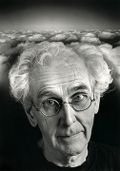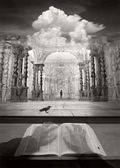06 Aug Jerry Uelsmann featured at Telluride Gallery of Fine Art
 Over the past week, Telluride Inside… and Out has been running a series of podcasts featuring commentary by renowned photographer Jerry Uelsmann about five of his mind-bending images. A show of his work begins today, August 6, 5:30 – 7:30 p.m., with an artist reception at the Telluride Gallery of Fine Art on Main Street.
Over the past week, Telluride Inside… and Out has been running a series of podcasts featuring commentary by renowned photographer Jerry Uelsmann about five of his mind-bending images. A show of his work begins today, August 6, 5:30 – 7:30 p.m., with an artist reception at the Telluride Gallery of Fine Art on Main Street.
Uelsmann’s opening is part of the First Thursday Art Walk, an all-day showcase of Telluride’s fine art and retail scene created by the Telluride Council for the Arts & Humanities. Venues are open late until eight.
Jerry Uelsmann began producing his dramatic photomontages in the 1960s, black-and-white images that are not at all black and white, rather unsettling alternatives to naturalism. These surrealistic, hyper, super or anti realities – call them what you like, the labels are just variations on a theme – amount to a psychic topography developed from things that happened at the fringes of Uelsmann’s consciousness. Clues to the meaning of the work, however, could be derived from artist’s symbolic vocabulary, which has remained surprisingly consistent over the years: nature and culture cross boundaries when interiors meld with exterior landscapes. Figures levitate and fly as in dreams, free of gravity. Monumental hands, a classic element in Surrealist photography of the 1920s and 1930s, appear everywhere. Other bizarre, even grotesque Surrealist motifs include disembodied human parts, humans merging with trees, rocks and water, animal, vegetable and mineral blending and intertwining, the stuff of the shadow world. Universal archetypes such as house, tree, sky and water, are all re-contextualized, forcing us to confront them like children, with wonder and for the first time.
 Confronted with these images, viewers are forced into an internal dialogue between what they know intellectually about photography – the medium depicts things as they are, right? – and what they are asked to confront. The inventive consciousness of Uelsmann’s viewers then becomes another element in the picture frame. Describing the work, scholars have drawn analogies to lyrical poetry, because the artist’s elusive work clearly falls into the narrative as well as the visual tradition.
Confronted with these images, viewers are forced into an internal dialogue between what they know intellectually about photography – the medium depicts things as they are, right? – and what they are asked to confront. The inventive consciousness of Uelsmann’s viewers then becomes another element in the picture frame. Describing the work, scholars have drawn analogies to lyrical poetry, because the artist’s elusive work clearly falls into the narrative as well as the visual tradition.
Content notwithstanding, composition in an Uelsmann is also a subject worth exploring. Uelsmann is considered a virtuoso in the the darkroom, where he pioneered and is continually perfecting new bravura developing techniques. For starters, on three or more of the eight enlargers in his darkroom, the artist combines parts or all of two or more negatives, which he burns and dodges (exposes sections to more or less light) to make his final, seamless black-and-white prints.
 Uelsmann refers to his unique way of working as “in-process” discovery or “post visualization,” an idea that turns Ansel Adams’s notion of pre-visualization on its head. Pre-visualization demands that a photographer see in his mind what he wants to create at the moment of exposure. Uelsmann’s theory allows photographers to rethink an image at any point in the photographic process, to imagine “what if.”
Uelsmann refers to his unique way of working as “in-process” discovery or “post visualization,” an idea that turns Ansel Adams’s notion of pre-visualization on its head. Pre-visualization demands that a photographer see in his mind what he wants to create at the moment of exposure. Uelsmann’s theory allows photographers to rethink an image at any point in the photographic process, to imagine “what if.”
Jerry Uelsmann was born in Detroit, Michigan in 1934. In the early 1950s, he attended Rochester Institute of Technology, where Minor White was among his teachers and a major influence. White is widely quoted as saying the goal of a serious photographer – read fine art, not point and shoot – is to get from the tangible (what things are) to the intangible (what else they are) to create visual metaphors.
After earning a masters degree at Indiana University, Uelsmann began teaching at the University of Florida in Gainesville, where he and his wife Maggie Taylor, the other half of the show at the Telluride Gallery of Fine Art, still make their home.
Uelsmann’s work is in the permanent collections of the Metropolitan Museum of Art, and the Museum of Modern Art in New York; the National Gallery of Art in Washington, D,C; the Victoria and Albert Museum in London and other major museums around the world.


Sorry, the comment form is closed at this time.